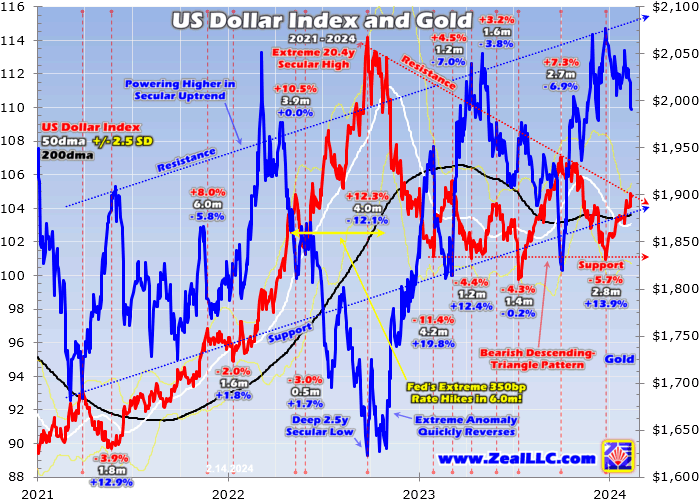The Pain in Silver & Gold Is Almost Over
February 15, 2024
In other words, one more lower low and up we go.
The levels to break on the upside in Silver to confirm the low is in place are the prior peaks at $23.15, $23.50 (200-DMA), and $23.72.
The same goes for Gold between $2040-$2060 and, of course, $2090.
POSITIONING OF THE FUNDS IN SILVER
The positioning of the Funds in Silver last Tuesday was already bullish, although it obviously allowed for slightly lower lows in price.

The Banks’ net position did not change much. It remained basically zero, neutral. This was bullish, but as I stated at the time, it could become even more bullish if the Banks decide to go long Silver.
Given the drop from $23.15 to $22 on Monday and Tuesday, aided by hawkish comments from Powell and the higher-than-expected Core CPI, it is not a stretch to believe that the Banks are now long. A further drop in price to a lower low and they are likely set up perfectly for a big rally.
More interesting was that the Funds (the dumb money in the chart above) went from 4k contracts net long to 5k net short last week. When the Funds are net SHORT, that is bullish. If the Banks now have gone from neutral to long, it is also likely that the Funds are even more short now with more to add if we hit a lower low. Again, extremely bullish for Silver. Not so good for the Funds—in the wrong place at the wrong time as always.
Suffice to say that the positioning alone suggests a bottom in Silver is imminent.
Turning to Gold…

Banks increased their net short position by 7.5k to 144k contracts. This was the first increase in five weeks.
They increased their net short position even though the Gold price was flat. That was bearish short-term for Gold.
The fact that the Funds added 12k contracts and their net long position is now 68k is also bearish short-term.
But given that the Gold price was $2055 when this data was recorded and has since fallen to $2000, the Banks have probably cut their net short position while the Funds cut their net long position.
History shows that a net short position of 120k contracts or less would be sufficient for a major low. Could the Banks have reduced their net short position by 24k contracts since Feb. 6? Sure they could, especially if Gold falls further to $1950.
What is clear is that the positioning in Silver is far more bullish than that in Gold, and this is one of the reasons why I believe Silver will lead the next rally higher. The Gold:Silver ratio is going to head south, imho.






















